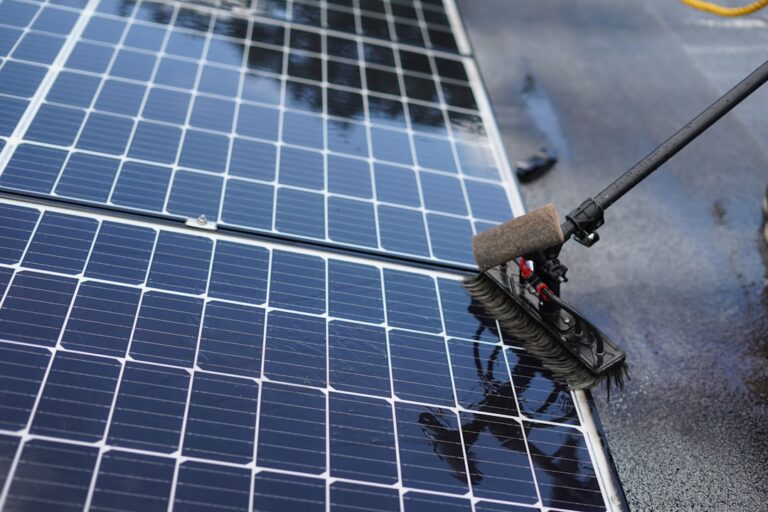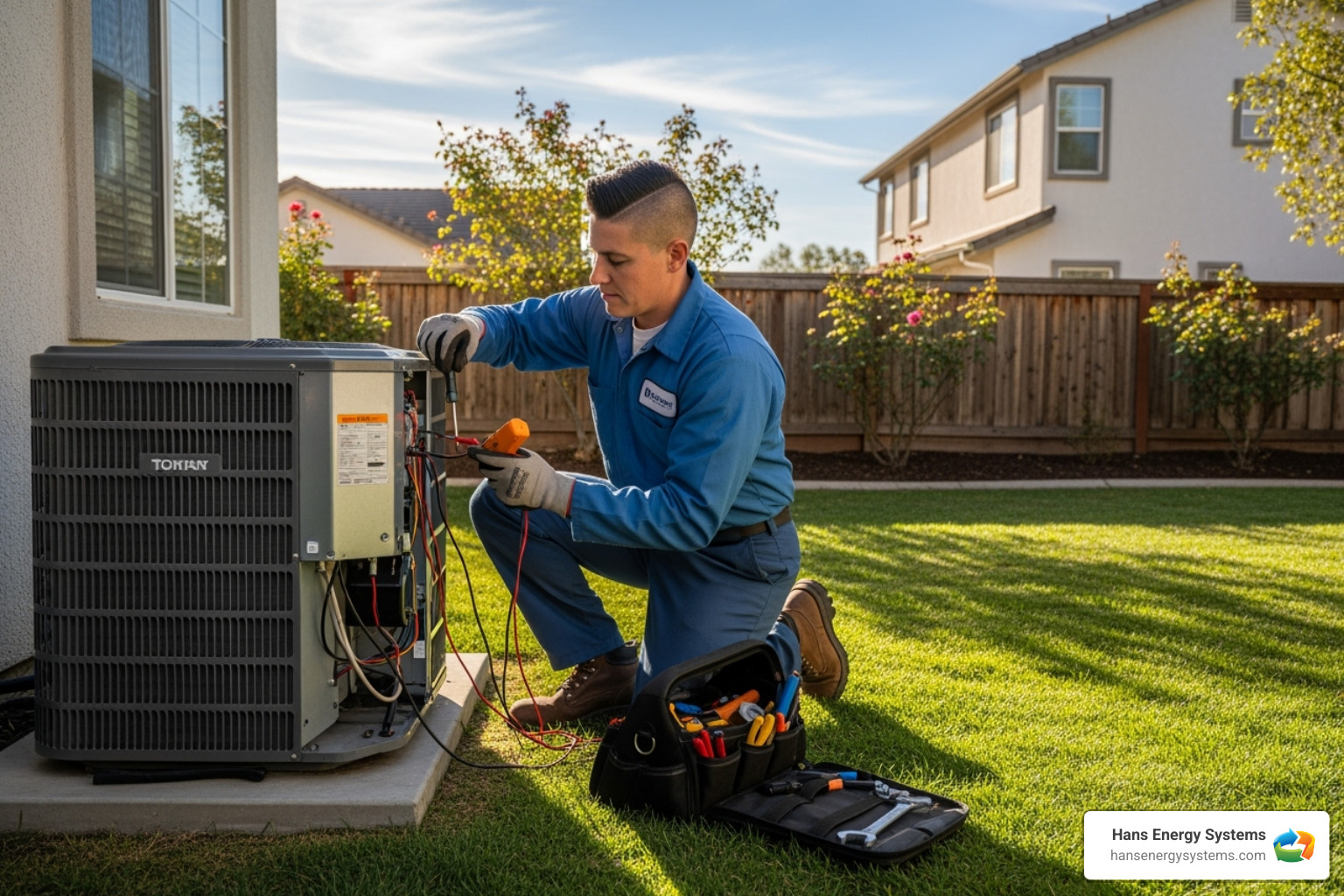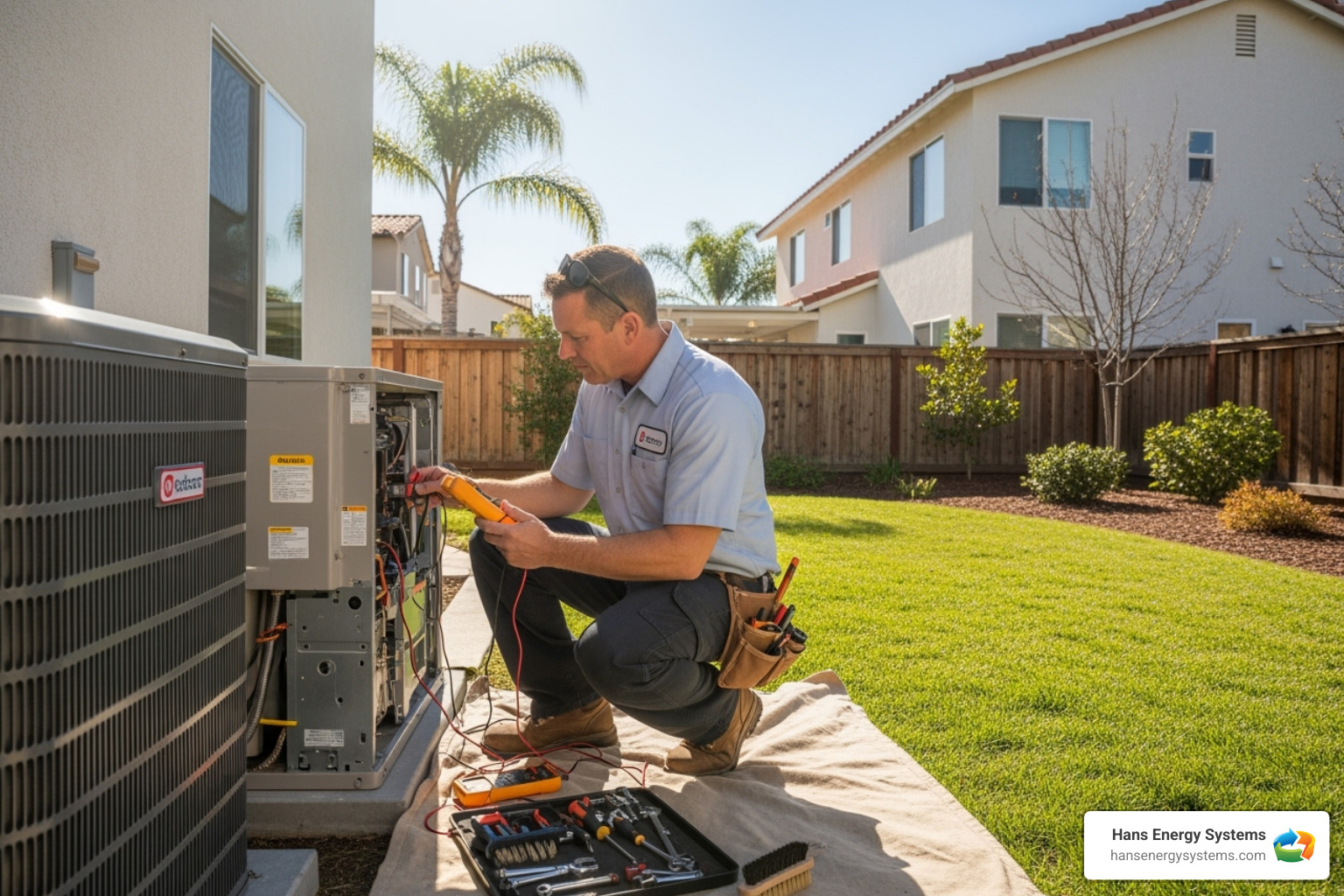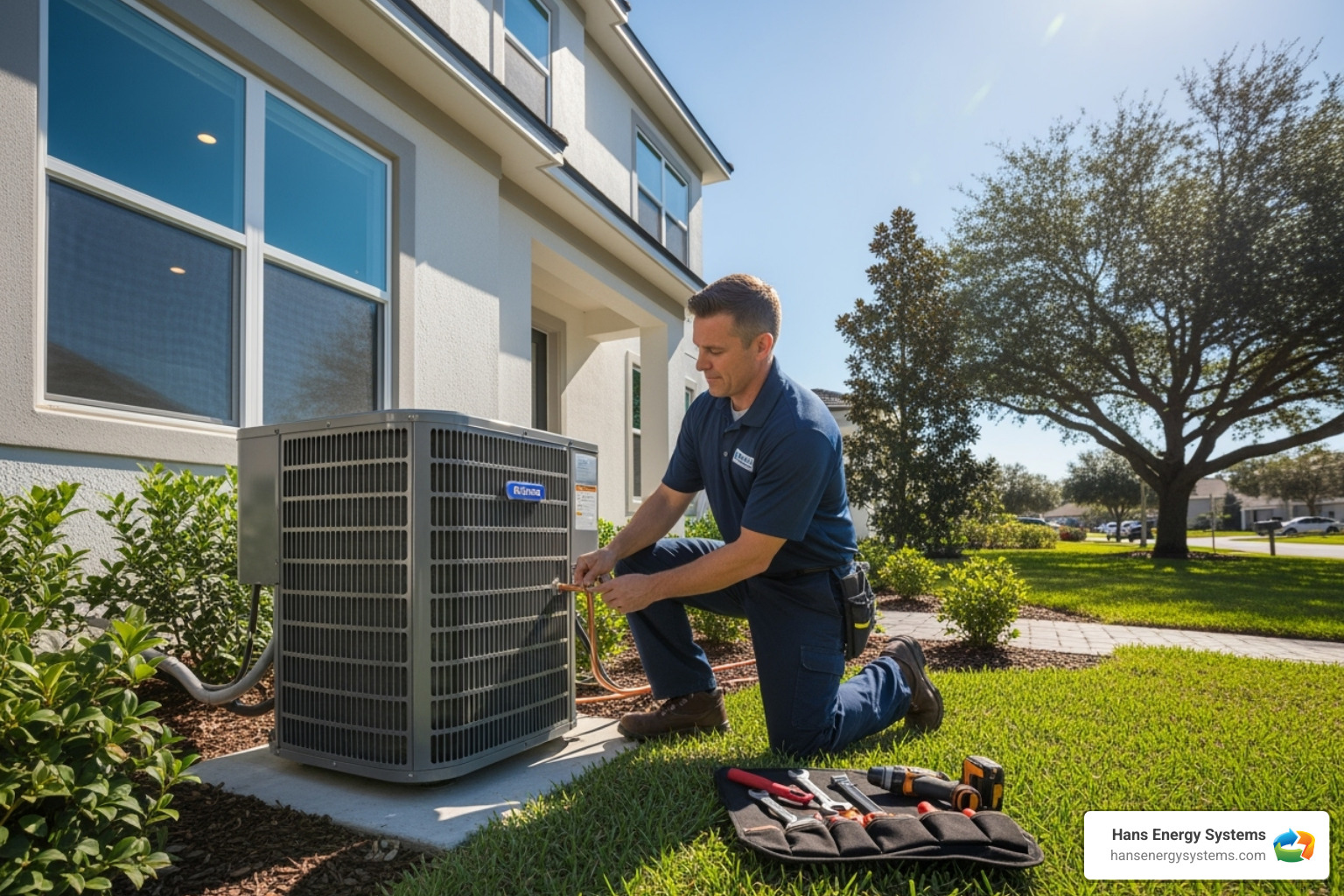Why Solar Energy Repairs Are Essential for Your Investment
Solar energy repairs are a normal part of owning solar panels, just like maintaining your car or HVAC system. While solar panels are built to last 20-30 years with proper care, they will eventually need attention to keep performing at their best.
Common solar repair needs include:
- Inverter issues – Communication errors, failure, or voltage problems
- Physical damage – Cracked glass, hail damage, or storm-related issues
- Electrical problems – Loose wiring, faulty connections, or circuit breaker trips
- Performance issues – Hot spots, microcracks, or degradation over time
- Weather damage – Debris buildup, pest damage, or mounting system rust
Understanding what to expect from the repair process helps you protect your solar investment and avoid costly surprises. Most repairs are straightforward when handled by qualified professionals, but knowing the warning signs and repair options keeps your system generating clean energy for decades.
The key is catching problems early through regular monitoring and professional inspections. A small issue today can become an expensive replacement tomorrow if ignored.
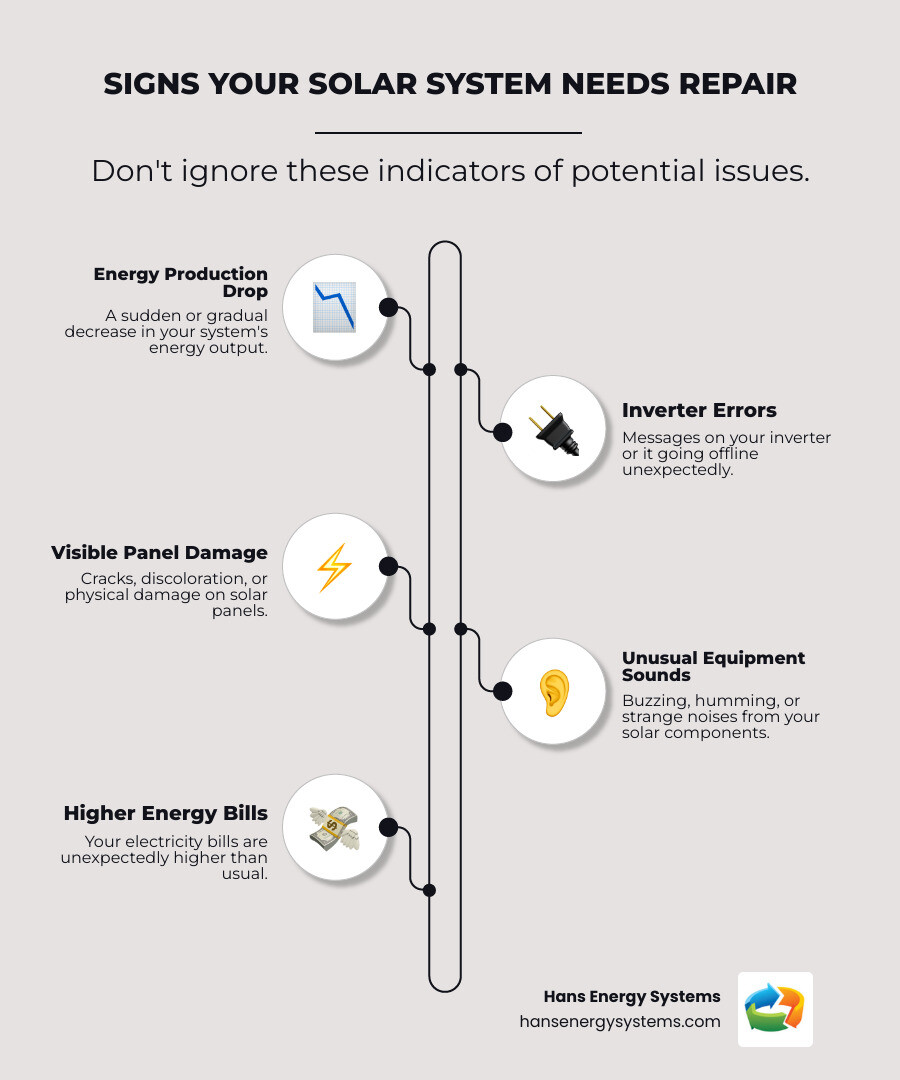
Diagnosing the Damage: Common Solar Panel Problems
Your solar system is like having a reliable friend who quietly takes care of business every day. Most of the time, it’s working hard in the background, converting sunshine into savings on your electric bill. But even the best systems occasionally need some attention, and knowing how to spot problems early can save you both money and headaches.
The first step in any solar energy repairs is figuring out what’s actually wrong. Many homeowners start by checking their system monitoring software, which tracks energy production in real-time. If you notice your panels aren’t producing as much power as usual, or if your electricity bills suddenly spike, that’s your system’s way of asking for help.
Sometimes the problem is obvious from a quick visual check from the ground. You might spot debris, damage, or something that just doesn’t look right. But for the hidden issues that can really impact performance, you need professional eyes and specialized equipment. That’s where our Professional Solar Panel Inspection in Poway comes in handy. We use thermal imaging cameras and other diagnostic tools to catch problems you’d never see otherwise.
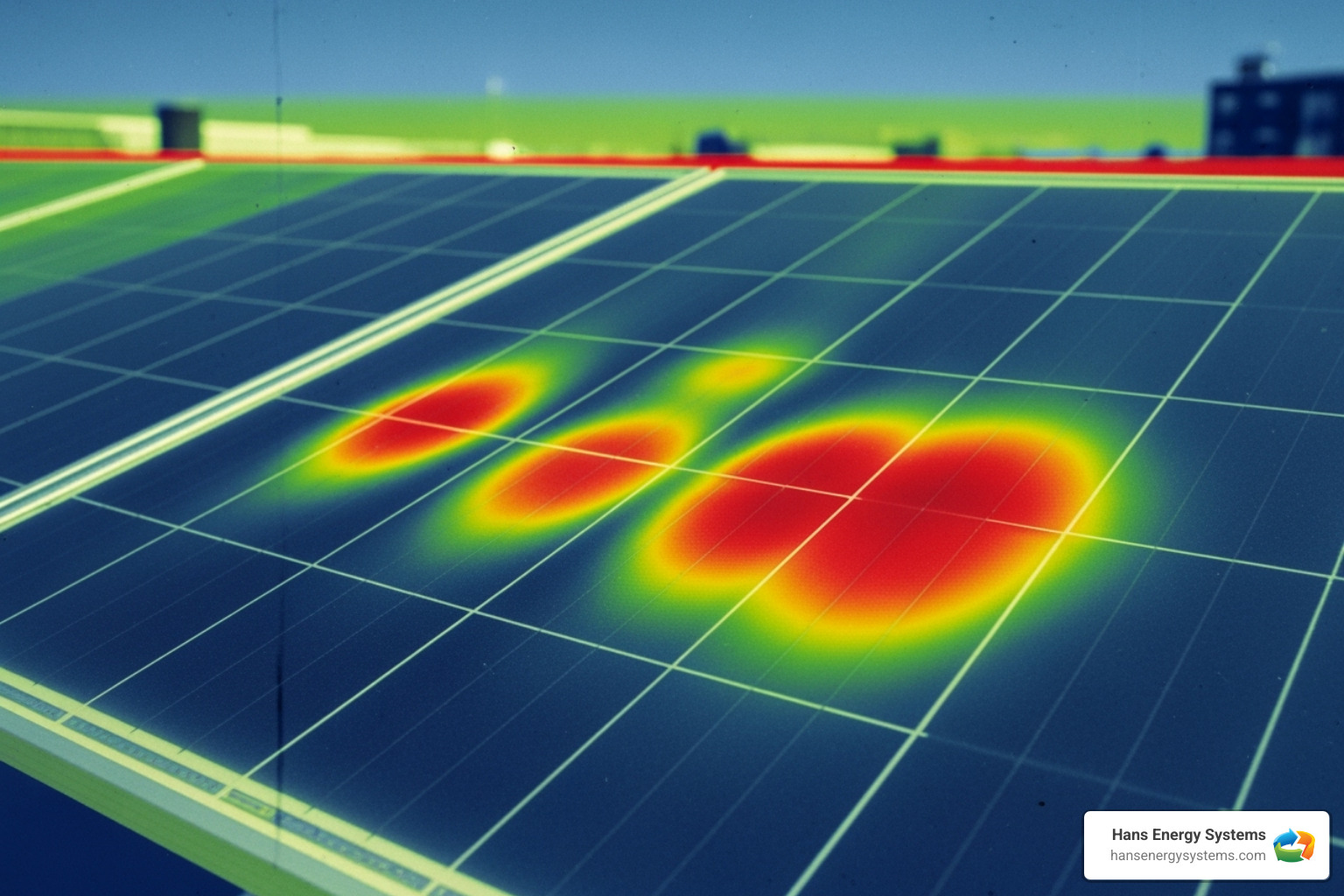
Physical and Weather-Related Damage
Solar panels are tough cookies, built to handle whatever Mother Nature throws at them. But sometimes she throws a curveball that even the strongest panels can’t handle perfectly.
Cracked glass is probably the most visible sign something’s wrong. A tree branch, severe hail, or even a stray baseball can chip or crack the protective glass surface. Small chips might not seem like a big deal, but they can let moisture sneak in, which leads to much bigger problems down the road.
Hail damage varies depending on the size of the ice chunks falling from the sky. We’ve seen panels survive golf ball-sized hail without a scratch, and we’ve also seen smaller hail cause surprising damage. It really depends on the angle, wind speed, and just plain bad luck.
Storm damage goes beyond just hail. High winds can loosen mounting hardware or shift panels out of alignment. Lightning strikes are rare but devastating when they happen. The good news is you can Protect Solar Panels from Storm Damage with proper installation and surge protection.
Debris buildup might sound minor, but it’s like trying to get a suntan through a dirty window. Bird droppings, leaves, dust, and general grime can significantly reduce your panels’ ability to absorb sunlight. Regular cleaning makes a huge difference in performance.
Here’s something that might surprise you: pest damage is more common than you’d think. Squirrels and rats love chewing on solar panel wiring, and birds enjoy building cozy nests underneath panels. We’ve become pretty good detectives at figuring out which critter caused the latest outage.
Rust on mounting hardware develops over time, especially in coastal areas with salt air. While it starts small, rust can eventually compromise the structural integrity of your entire system, making panels loose or even unsafe.
Invisible Threats: Microcracks, Hot Spots, and Degradation
The sneakiest problems are the ones you can’t see. These invisible issues can slowly eat away at your system’s performance without giving you any obvious warning signs.
Microcracks are tiny fractures in the solar cells themselves. They can happen during manufacturing, shipping, installation, or just from years of thermal cycling – the constant expansion and contraction as panels heat up during the day and cool down at night. These hairline cracks might not affect performance immediately, but they tend to grow over time.
Hot spots are exactly what they sound like – areas on your panels that get much hotter than they should. They’re often caused by microcracks, partial shading, or manufacturing defects. Our thermal cameras can spot these problem areas even when they’re not visible to the naked eye. Left untreated, hot spots can lead to permanent damage.
Potential Induced Degradation (PID) is a fancy term for what happens when voltage differences between your panels and their grounding cause power loss. The good news is that PID is often reversible with the right treatment.
Delamination occurs when the layers inside your solar panels start separating. You might notice bubbling or discoloration under the glass. The effects of delamination include moisture getting inside the panel, which can cause corrosion and electrical problems.
Snail trails are dark, winding patterns that sometimes appear on panels over time. While they’re mostly cosmetic, severe cases can indicate moisture problems or chemical reactions that might eventually affect performance.
The Heart of the System: Inverter and Battery Issues
If your solar panels are the muscles of your system, the inverter is definitely the brain. It takes the DC electricity your panels produce and converts it into the AC electricity your home uses. When inverters have problems, your entire system can go offline.
Inverter failure is often the culprit when customers call us about sudden drops in power production. The inverter might show error codes, stop communicating with monitoring software, or simply refuse to turn on. Since everything depends on the inverter working properly, this usually needs immediate attention.
Communication errors can be tricky to diagnose. Your inverter might be working fine but not talking to your monitoring system. This makes it hard to track performance and catch other problems early.
No voltage output is a clear sign something’s seriously wrong. This usually requires professional diagnostic equipment to pinpoint whether the problem is with the inverter, wiring, or panels themselves.
The type of inverter system you have makes a difference in troubleshooting. String inverters connect multiple panels together, so one problem panel can affect the whole string’s output. Micro inverters are installed on each individual panel, which means problems stay isolated to just one panel instead of affecting your entire system.
If you have battery malfunctions, you might notice your stored energy running out faster than usual, batteries not charging completely, or your backup power not kicking in during outages. For homeowners interested in adding or upgrading their storage, our Energy Storage Solutions for Solar Systems can help optimize your setup.
Electrical Faults: Wiring and Connections
The network of wires and connections in your solar system is like the circulatory system of your home’s energy production. When something goes wrong here, it can range from minor efficiency losses to serious safety hazards.
Loose wiring develops over time as connections experience temperature changes and vibration from wind. Sometimes the problem is as simple as a connection that needs tightening, but other times it’s more complex damage from weather or (believe it or not) mice who decided your wiring looked tasty.
Faulty connections create electrical resistance, which reduces power flow and can cause dangerous heat buildup. Damaged cables might result from UV exposure, physical wear, or improper installation techniques.
Circuit breaker trips are your electrical system’s way of protecting itself, but frequent tripping usually indicates an underlying problem like an overload or short circuit. Grounding issues are particularly serious because proper grounding is essential for electrical safety.
When it comes to electrical problems, safety always comes first. That’s why we take pride in How We Handle Solar Panel Repair in Poway – our certified technicians have the training and equipment to diagnose and fix these issues safely and effectively.
Understanding the Costs of Solar Energy Repairs
Nobody likes surprise expenses, especially when it comes to home repairs. When your solar system starts acting up, the first question that probably crosses your mind is: “What’s this going to cost me?”
We get it – and we want to help you understand what goes into solar energy repairs pricing so you can make informed decisions about your investment.
The truth is, repair costs can vary quite a bit depending on what’s actually wrong. A simple wiring fix might cost you a couple hundred dollars, while replacing a major component like an inverter could run into the thousands. The good news? Many issues are covered under warranty, so always check your paperwork before assuming you’ll pay out of pocket.
Several factors influence the final bill: the type and extent of damage, whether parts need replacing or can be repaired, labor complexity, and your system’s age and configuration. Think of it like car repairs – fixing a flat tire is different from rebuilding an engine.
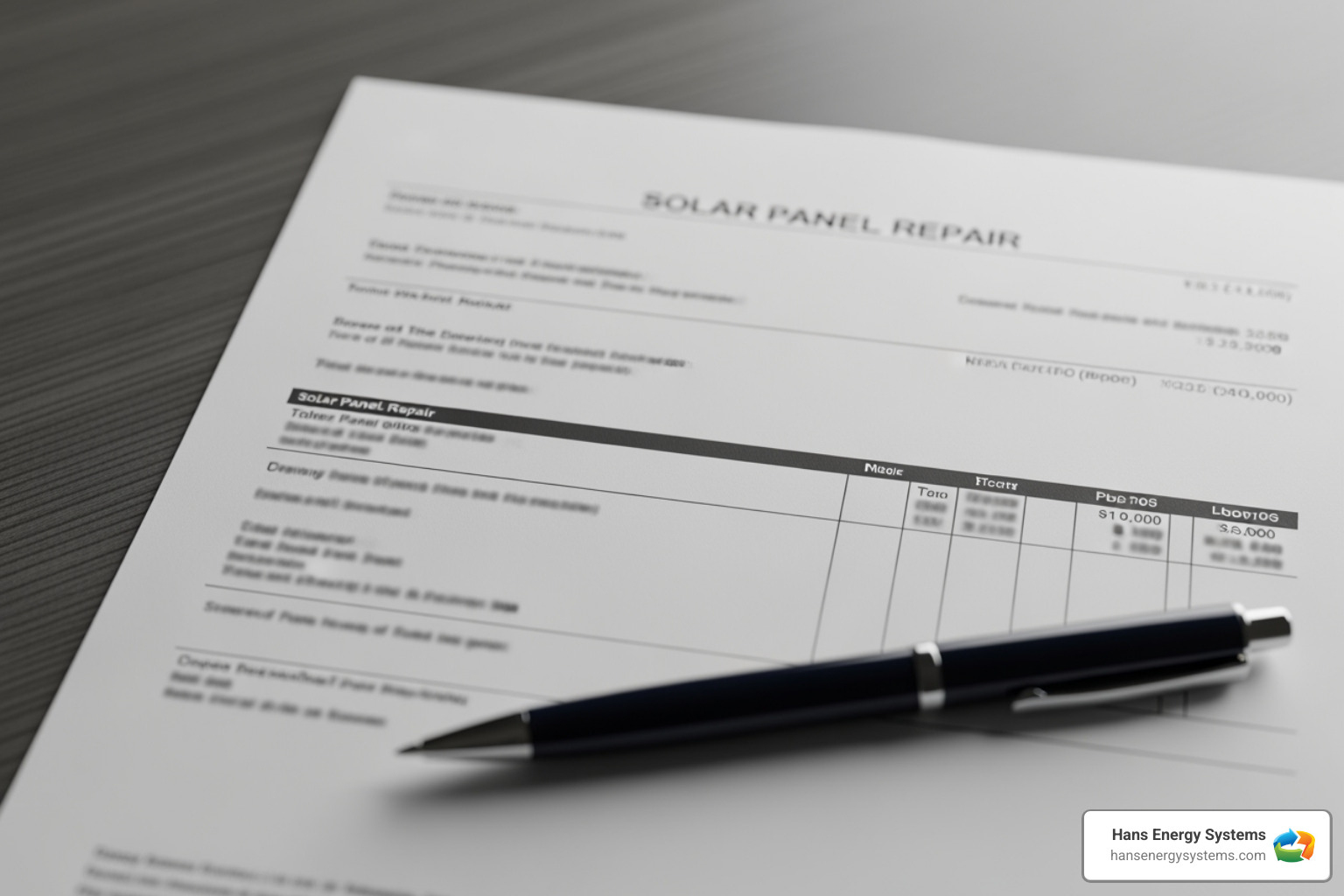
The Financial Breakdown of Solar Energy Repairs
Here’s where things get practical. While every situation is unique, understanding typical cost ranges helps you budget and avoid sticker shock when you get a quote.
Inverter issues tend to be among the more expensive repairs, ranging from moderate fixes to significant replacements. These are the workhorses of your system, so when they go down, the repair complexity reflects their importance.
Physical damage like cracked glass or hail damage usually falls into the moderate range per panel. The silver lining? This type of damage is often covered by homeowner’s insurance, especially if it’s weather-related.
Electrical problems such as loose wiring or connection issues are typically on the lower end of the cost spectrum. These are often quick fixes for experienced technicians, though safety requirements mean they should never be DIY projects.
Leak repairs can be surprisingly costly because they often require removing and reinstalling panels to access and fix the underlying roof issue. It’s not just about the electrical work – it’s about protecting your home’s integrity.
Battery system repairs have the widest cost range, from simple fixes to complete system overhauls, depending on the technology and extent of the problem.
| Repair Type | Average Cost Range |
|---|---|
| Inverter Repair | $500 to $3,000 |
| Cracked Glass | $120 to $500 |
| Loose Wiring | $100 to $400 |
| Leak Repair (beneath panel) | $1,200 to $1,500 |
| Hail Damage (per panel) | $120 to $500 |
| Rust Removal | $150 to $350 |
| No Voltage | $400 to $3,000 |
| Inverter Not Communicating | $500 to $3,000 |
| Panel Replacement (single) | $300 to $500 |
| Battery Repair | $200 to $15,000 |
These are national averages. Your actual costs might differ based on your specific situation, local labor rates, and the complexity of accessing your system.
Repair vs. Replacement: Making the Right Call
This decision can feel overwhelming, but it doesn’t have to be. We help homeowners steer this choice every day, and there are some clear guidelines that make the decision easier.
Age matters more than you might think. If your panels are approaching their 20-year mark and need major repairs, it might make more sense to upgrade to newer, more efficient technology. You’ll get better performance and a fresh warranty period.
Damage extent is usually pretty obvious once we take a look. Small chips and minor issues? Usually worth repairing. Extensive cracking, severe weather damage, or multiple failing components? Replacement often makes more financial sense.
The cost-effectiveness calculation is where our experience really helps. Sometimes a repair that seems expensive is actually a bargain compared to replacement. Other times, spending money on an old component is like putting new tires on a car that needs a new engine.
System efficiency is crucial because solar panels work together. One underperforming panel can drag down your entire system’s output, especially with string inverters. We always consider the Significance of Solar Panel Efficiency when making repair recommendations.
Future performance is the final piece of the puzzle. We’re not interested in band-aid solutions that’ll have you calling us back in six months. Our recommendations focus on getting your system back to reliable, long-term performance that protects your investment for years to come.
The bottom line? We’ll always give you honest advice about whether repair or replacement makes the most sense for your specific situation and budget.
The Professional Repair Process and Safety
When your solar system starts acting up, bringing in the professionals isn’t just the smart choice – it’s the safe one. At Hans Energy Systems, our solar energy repairs follow a clear, step-by-step process that keeps you informed and your system running smoothly.
Everything starts with our initial consultation. Maybe you’ve noticed your energy bill creeping up, or perhaps that little green light on your inverter has mysteriously turned red. Whatever the symptom, we listen carefully to understand what’s happening with your system.
Next comes the detective work – our system diagnosis. Our certified technicians arrive at your Poway home equipped with all the specialized tools needed to get to the bottom of the problem. We use multimeters to check electrical components, thermal cameras to spot those sneaky hot spots, and we’ll dive into your inverter’s diagnostic codes to see what story it’s telling us.
Once we’ve cracked the case, we move to quoting. No mysterious estimates or surprise fees here – we’ll explain exactly what needs fixing, why it’s necessary, and what it’ll take to get your system back to peak performance. We believe in complete transparency because, frankly, solar repairs can feel overwhelming enough without hidden costs.
After you give us the green light, we handle scheduling the repair around your busy life. Our team shows up when promised, works efficiently, and treats your property with respect.
But here’s where we really shine – we don’t just fix the problem and walk away. Our post-repair testing includes power measurements, flash tests, and insulation checks to make absolutely sure everything is working perfectly. This thorough approach is part of what makes us experts at How Experts Handle Solar Panel Repair Poway.
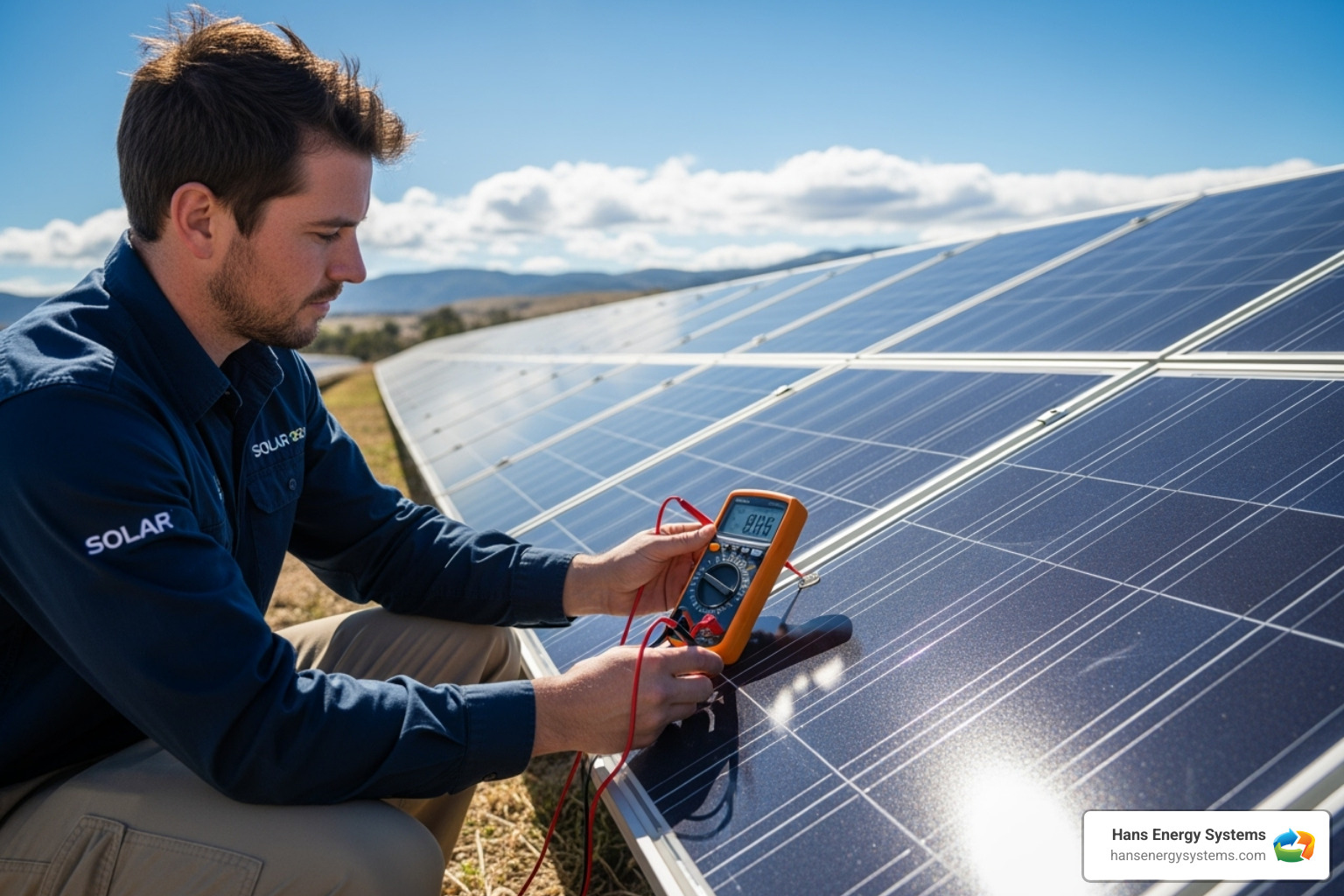
DIY vs. Professional Solar Energy Repairs: A Safety Warning
We totally understand the urge to roll up your sleeves and tackle a repair yourself. There’s something satisfying about fixing things with your own hands, plus it seems like it could save some money. But when it comes to solar energy repairs, we need to have a serious conversation about safety.
Electrical shock risk is the big one here. Solar panels generate DC electricity even when your system is disconnected from the grid – they’re literally designed to create power whenever sunlight hits them. Without proper training and the right insulated tools, you’re playing with fire. We’ve seen too many close calls to take this lightly.
Then there’s the rooftop safety hazard. Working on any roof is dangerous, but add solar panels to the mix and you’ve got extra obstacles, slippery surfaces, and electrical components to steer. Professional solar technicians use specialized safety equipment and have extensive training for working at heights safely.
Here’s something that might surprise you – attempting DIY repairs can void your warranties. Most manufacturers have strict clauses about who can work on their equipment. One well-meaning DIY attempt could leave you without warranty protection when you really need it.
Specialized tools are another consideration. Proper solar diagnostics require equipment that most homeowners simply don’t have sitting in their garage. Without the right tools, you’re essentially guessing at what’s wrong.
Perhaps most importantly, there’s the risk of turning a small problem into a big one. We’ve been called out to fix “simple” DIY repairs that ended up causing thousands of dollars in additional damage. What started as a minor wiring issue became a major system overhaul.
Your safety and your solar investment are both too valuable to risk. This is especially true if you have battery backup systems, where understanding Home Safety with Battery Backup Systems becomes even more critical.
Trust us – some things are worth leaving to the professionals.
Proactive Protection: Maintenance to Prevent Future Repairs
The best solar energy repairs are the ones you never have to make! Just like you wouldn’t skip oil changes for your car, your solar system thrives with a little regular attention. The good news? Solar maintenance is much simpler than most people think.
Regular inspections are your first line of defense. Take a walk around your property every few months and give your panels a visual once-over from the ground. You’re looking for obvious signs like cracked glass, debris buildup, or evidence that local wildlife has decided your solar array makes a perfect apartment complex. While these ground-level checks are helpful, scheduling an annual professional inspection catches the sneaky problems that aren’t visible to the naked eye.
Your system monitoring software is like having a health tracker for your solar system. Make checking your production data as routine as checking the weather. Most apps show daily, weekly, and monthly energy production, and you’ll quickly learn what’s normal for your system. A sudden drop in performance or consistently lower numbers than expected are your early warning signals that something needs attention.
Keeping panels clean might seem obvious, but it’s amazing how much dirt, pollen, and bird droppings can accumulate over time. Think of it this way: you wouldn’t expect to see clearly through a dirty windshield, and your panels can’t collect sunlight efficiently when they’re covered in grime. A gentle cleaning every 6-12 months with a soft brush and non-abrasive cleaner works wonders. Just remember – never use a pressure washer, which can damage the panel surface.
Trimming trees around your solar installation prevents shading issues that can dramatically reduce your system’s output. Even a small shadow cast across a panel for part of the day can create hot spots and reduce efficiency. Keep an eye on how your landscape changes with the seasons, especially in spring when trees are growing rapidly.
Pest prevention saves you from some of the most frustrating repair calls we receive. Installing critter guards around your array’s perimeter keeps squirrels, birds, and other animals from treating your solar system like their personal playground. Trust us – preventing a pest problem is much easier than cleaning up after one!
For detailed guidance on keeping your system performing at its best, check out our comprehensive guide on Solar Panel Cleaning and Maintenance.
Here’s a simple seasonal maintenance approach that takes the guesswork out of solar care:
- Spring: Check for winter damage, give panels a thorough cleaning, and watch for new shading as trees leaf out
- Summer: Monitor your production data regularly, keep vegetation trimmed, and watch for increased bird activity
- Fall: Clear leaves and debris, inspect for physical damage before winter, and consider a final cleaning
- Winter: Monitor for ice buildup, remove heavy snow if safe to do so, and stay alert for pest activity as animals seek shelter
The beauty of this proactive approach is that it turns potential emergency repairs into routine maintenance – saving you money and keeping your solar investment performing at its peak for decades to come.
Conclusion
Your solar investment represents more than just panels on your roof – it’s a commitment to your financial future and the environment. Solar energy repairs play a crucial role in protecting that investment and ensuring you get every bit of value from your system over its 20-30 year lifespan.
Think of it this way: you wouldn’t skip oil changes for your car and expect it to run perfectly for decades. Your solar system deserves the same attention and care. Whether it’s addressing visible damage like cracked glass or hidden issues like microcracks and hot spots, staying on top of repairs keeps your system humming along efficiently.
The math is simple. Proactive maintenance and timely repairs cost far less than letting small problems grow into system-wide failures. A loose wire fixed today prevents a major electrical fault tomorrow. A cracked panel replaced now saves you from water damage that could affect multiple components later.
Professional service isn’t just recommended – it’s essential for your safety and your wallet. The electrical components in your solar system can be dangerous, and specialized diagnostic tools are needed to properly identify issues. Plus, DIY attempts often void warranties that could save you thousands down the road.
At Hans Energy Systems, we’ve seen how proper care transforms a solar system from a simple purchase into a decades-long source of savings and peace of mind. Our team understands that every repair is about more than fixing a problem – it’s about maximizing your ROI and keeping your family’s energy future secure.
Your solar system works hard for you every sunny day in San Diego County. When it needs a little help, we’re here to provide the expert diagnosis and reliable service that keeps it performing at its best.
Ready to give your solar system the professional attention it deserves? Schedule Your Solar Panel Repair in Poway, CA Today and let us help keep your investment shining bright for years to come.


